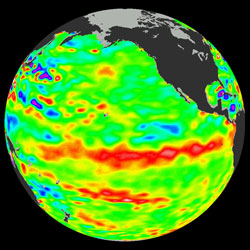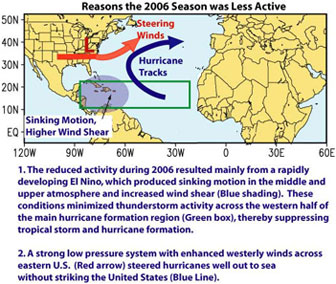Saved by el Nino! Warm Pacific means fewer hurricanes
Saved by el Nino! Warm Pacific means fewer hurricanes
mongabay.com
November 30, 2006
El Niño’s to blame for the quiet 2006 hurricane season according to researchers at the U.S. National Oceanic and Atmospheric Administration (NOAA).
While some climate scientists forecast a big hurricane year in 2006, the official six-month season produced only nine tropical storms and hurricanes, below the average of 11. For the first time since 1997, there were no Category 4 or 5 hurricanes, the strongest type of storm. 2005 saw the worst hurricane season on record with 28 storms including 3 category 5 storms: Hurricanes Katrina, Rita, and Wilma. Hurricane Katrina caused some $80 billion in damage as it destroyed the city of New Orleans.
Researchers say that El Niño, a periodic warming of the eastern Pacific ocean, tends to surpress hurricane activity in the Atlantic by increasing wind shear that disrupts storm formation. ElNiño is also correlated with above average precipitation in the wastern United States and coastal South America, and droughts in Indonesia and northern Australia.
 NASA image by Akiko Hayashi, Jet Propulsion Laboratory. |
“The development of El Niño conditions by September helps explain why this Atlantic hurricane season was less active than predicted,” said Gerry Bell, NOAA’s lead forecaster on the Atlantic hurricane seasonal outlook team. “El Niño developed quickly and the atmosphere responded rapidly, reducing hurricane activity during an otherwise active era that began in 1995.”
According to NASA, late 2006 has been characterized by weak elNiño conditions in the the tropical Pacific Ocean, but scientists are unsure how long the conditions will persist, meaning strong hurricanes could return as soon as next year.
“Getting a quick handle on El Niño events, which rapidly intensify, is essential for predicting seasonal hurricane activity,” said Bell. “The last time we had a rapidly developing El Niño was during the 2002 hurricane season, which also led to near-normal activity. NOAA continues to develop and improve climate models to better predict the onset of El Niño, its impacts on weather patterns in the United States and its effects on Atlantic hurricane activity.”

NOAA image for larger view of explanation as to why the
2006 Atlantic hurricane season turned out less active than predicted.
This article uses information a NOAA news release.